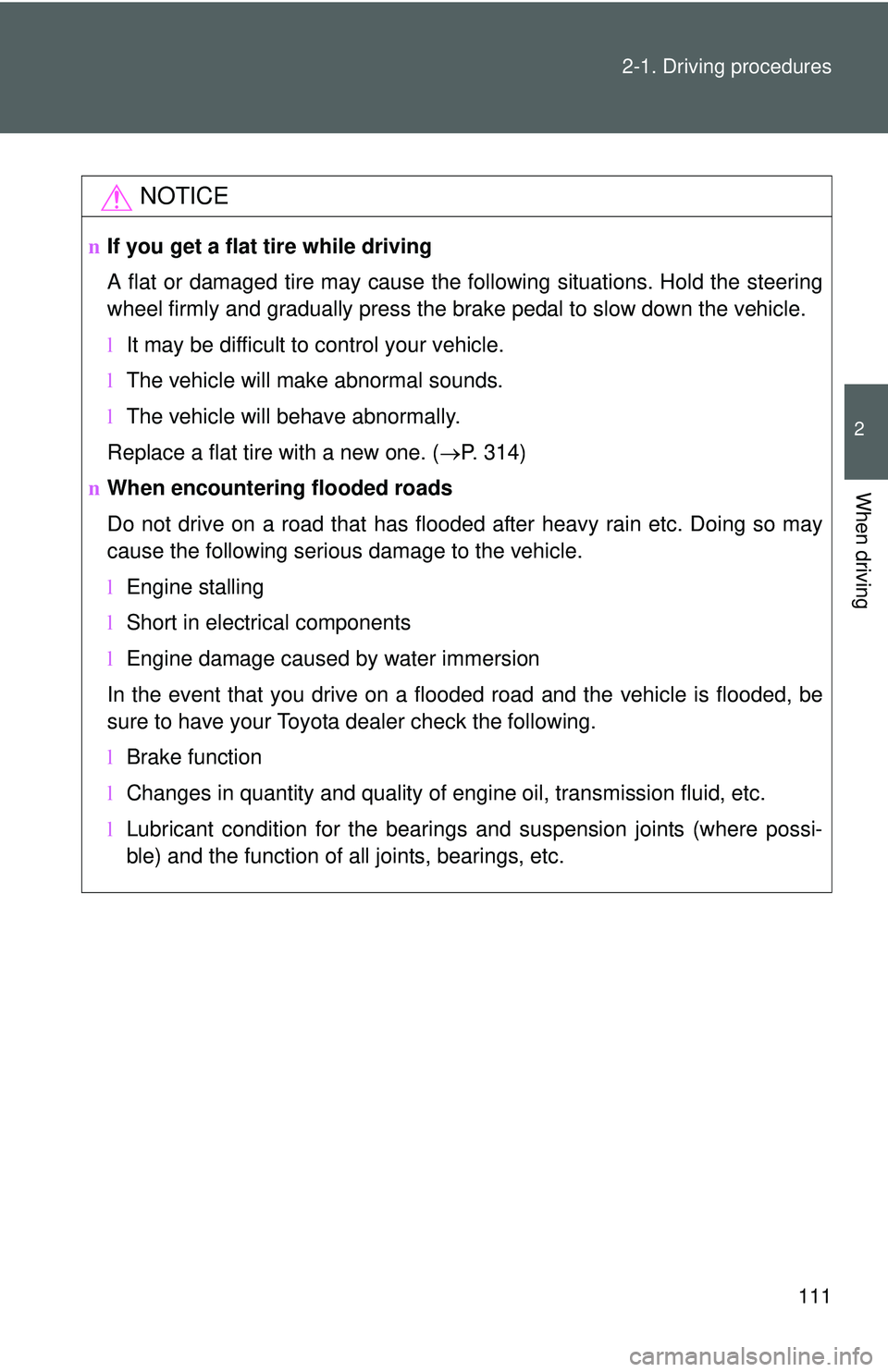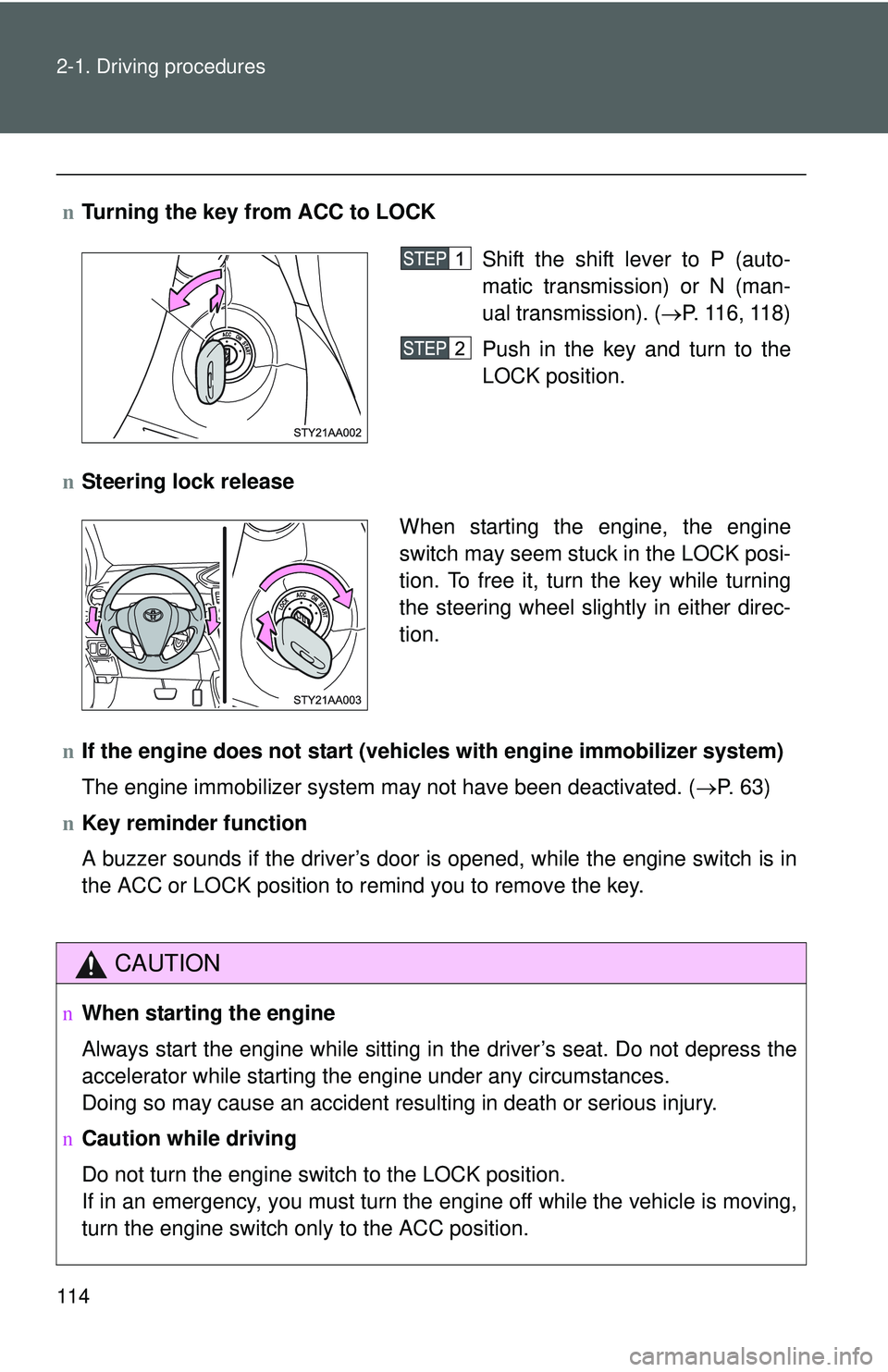Page 124 of 406

111
2-1. Driving procedures
2
When driving
NOTICE
n
If you get a flat tire while driving
A flat or damaged tire may cause the following situations. Hold the steering
wheel firmly and gradually press the brake pedal to slow down the vehicle.
lIt may be difficult to control your vehicle.
l The vehicle will make abnormal sounds.
l The vehicle will behave abnormally.
Replace a flat tire with a new one. ( →P. 314)
n When encountering flooded roads
Do not drive on a road that has flooded after heavy rain etc. Doing so may
cause the following serious damage to the vehicle.
lEngine stalling
l Short in electrical components
l Engine damage caused by water immersion
In the event that you drive on a flooded road and the vehicle is flooded, be
sure to have your Toyota dealer check the following.
l Brake function
l Changes in quantity and quality of engine oil, transmission fluid, etc.
l Lubricant condition for the bearings and suspension joints (where possi-
ble) and the function of all joints, bearings, etc.
Page 125 of 406
112
2-1. Driving procedures
Engine (ignition) switch
nEngine switch
LOCK
The steering wheel is locked
and the key can be removed.
(Vehicles with an automatic
transmission: The key can be
removed only when the shift
lever is in P.)
ACC
Some electrical components
such as the audio system can
be used.
ON
All electrical components can
be used.
START
For starting the engine.
nStarting the engine
Automatic transmission
Check that the parking brake is set.
Check that the shift lever is set in P.
Sit in the driver’s seat and firmly depress the brake pedal.
Turn the engine switch to the START position and start the
engine.
The engine will crank until it starts or for up to 20 seconds, which-
ever is less.
Continue depressing the brake pedal until the engine is com-
pletely started.
Page 126 of 406
113
2-1. Driving procedures
2
When driving
Manual transmission
Check that the parking brake is set.
Check that the shift lever is set in N.
Firmly depress the brake pedal and clutch pedal.
Turn the engine switch to the START position and start the
engine.
The engine will crank until it starts or for up to 20 seconds, which-
ever is less.
Continue depressing the brake pedal and clutch pedal until the
engine is completely started.
Page 127 of 406

114 2-1. Driving procedures
nTurning the key from ACC to LOCK
n Steering lock release
n If the engine does not start (vehic les with engine immobilizer system)
The engine immobilizer system may not have been deactivated. ( →P. 63)
n Key reminder function
A buzzer sounds if the driver’s door is opened, while the engine switch is in
the ACC or LOCK position to remind you to remove the key.
CAUTION
nWhen starting the engine
Always start the engine while sitting in the driver’s seat. Do not depress the
accelerator while starting the engine under any circumstances.
Doing so may cause an accident resulting in death or serious injury.
n Caution while driving
Do not turn the engine switch to the LOCK position.
If in an emergency, you must turn the engine off while the vehicle is moving,
turn the engine switch only to the ACC position.
Shift the shift lever to P (auto-
matic transmission) or N (man-
ual transmission). ( →P. 116, 118)
Push in the key and turn to the
LOCK position.
When starting the engine, the engine
switch may seem stuck in the LOCK posi-
tion. To free it, turn the key while turning
the steering wheel slightly in either direc-
tion.
Page 128 of 406
115
2-1. Driving procedures
2
When driving
NOTICE
n
To prevent battery discharge
Do not leave the engine switch in the ACC or ON position for long periods if
the engine is not running.
n When starting the engine
lDo not crank for more than 30 seconds at a time. This may overheat the
starter and wiring systems.
l Do not race a cold engine.
l If the engine becomes difficult to start or stalls frequently, have the engine
checked immediately.
Page 129 of 406
116
2-1. Driving procedures
Automatic transmission∗
∗: If equipped
Select a shift position appropriate for the driving conditions.
nShifting the shift lever
While the engine switch is on, depress the brake pedal and
move the shift lever.
Page 130 of 406
117
2-1. Driving procedures
2
When driving
n
Downshifting restrictions
The shift lever cannot be downshifted if the following speeds are exceeded.
mph (km/h)
n When driving with the cruise control system
The engine brake will not operate when downshifting from D to 3. ( →P. 138)
n If the shift lever cannot be shifted from P (→P. 324)
n Shift position uses
*: Shifting to the D position allows the system to select a gear suitable
for the driving conditions. Setting the shift lever to the D position is
recommended for normal driving.
Shift positionFunction
PParking the vehicle or starting the engine
RReversing
NNeutral
DNormal driving*
3Position for engine braking
2Position for more powerful engine braking
LPosition for maximum engine braking
DownshiftingTire sizeMaximum speed
3 → 2 175/65R14
53 (86)
185/60R15 54 (88)
2 → L 175/65R14
26 (43)
185/60R15 27 (44)
Page 132 of 406
119
2-1. Driving procedures
2
When driving
Turn signal lever
nTurn signals can be operated when
The engine switch is in the ON position.
n If the indicators flash faster than usual
Check that a light bulb in the front or rear turn signal lights has not burned
out.
Left turn
Right turn
Move and hold the lever
partway to signal a lane
change.
The left hand signal will flash
until you release the lever.
Move and hold the lever
partway to signal a lane
change.
The right hand signal will flash
until you release the lever.